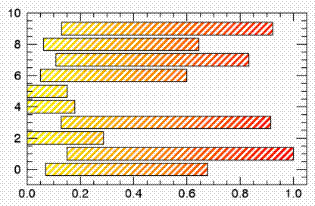32365
What's New in IDL 8.5
IDL 8.5 includes new features and functionality such as a new bi-directional IDL-Python bridge, new time series routines, a new color picker, new functional programming enhancements, and more. Learn how IDL 8.5 can help you interpret your data, expedite discoveries, and deliver powerful applications to market.
Note: If you are new to IDL or upgrading from an older
version, refer to the What's New topics for previous releases.
New Features
Python Bridge
IDL now has a bridge from IDL to Python and Python to IDL.
From your IDL code, you can now access any Python modules,
transfer variables, and call built-in functions. Similarly, from your
Python code, you can make IDL calls, transfer variables, and manipulate
IDL objects. The bridge has the following features:
- Works with Python 2.7+ and Python 3.4+
- Access to all IDL routines and Python
modules
- Seamless: looks just like an IDL object or
Python module
- All bridge output is redirected to the
standard output
- Case sensitivity and row/column major is
handled automatically
- Can execute arbitrary command strings in
either language
- Automatic data conversion from IDL arrays
to numpy arrays
- Data is passed by reference when calling
routines/methods
- Can pass main variables back &
forth
For example, within IDL, you could execute the following
Python commands to create a matplotlib plot:
IDL> ran =
Python.Import('numpy.random')
IDL> arr = ran.rand(100) ; call "rand" method
IDL> plt = Python.Import('matplotlib.pyplot')
IDL> p = plt.plot(arr) ; call
"plot", pass an array
IDL> void = plt.show(block=0) ; pass keyword
Within IDL, you can also directly enter Python "command-line
mode":
IDL> >>>
<>>> import matplotlib.pyplot as
plt
>>> import numpy.random as ran
>>> arr = ran.rand(100)
>>> p = plt.plot(arr)
>>> plt.show()
>>>
IDL>
On the Python side, you can easily access all
IDL functionality:
>>> from idlpy
import IDL
>>> import numpy.random as ran
>>> arr = ran.rand(100)
>>> p = IDL.plot(arr, title='My Plot')
>>> p.color = 'red'
>>> p.save('myplot.pdf')
>>> p.close()
For more information see the Python Bridge documentation in
IDL Help.
IDL IPython Notebook Kernel
Along with the Python Bridge, IDL now has a kernel
for running IDL in an IPython notebook. See the Python Bridge
documentation in IDL Help for details.
Color Selection
The DIALOG_COLORPICKER
function allows you to interactively select a color using a selection
dialog. The basic dialog grid includes 64 standard colors. You can set
custom and preferred colors using keywords.
Function Pointers
IDL_Object has a new _overloadFunction method which allows you
to create "function pointers" in IDL. By implementing
IDL_Object::_overloadFunction for your class, you can have your object
behave like an IDL function.
Dynamic Methods
IDL_Object has a new _overloadMethod method which allows you
to create "dynamic methods" in IDL. By implementing
IDL_Object::_overloadMethod for your class, your users can call
arbitrary methods on your object.
IDL_Variable::ToList Method
You can use the new IDL_Variable::ToList method to easily
convert IDL variables into lists.
WGET to Retrieve URL Files
You can use the new WGET
function to quickly and easily retrieve files from URLs:
IDL>
WGET('http://www.google.com/index.html',FILENAME='test.html')
C:\test.html
Updates
BARPLOT, ELLIPSE, and POLYGON now support fill patterns
BARPLOT, ELLIPSE, and POLYGON now have four new properties:
PATTERN_BITMAP, PATTERN_ORIENTATION, PATTERN_SPACING, and
PATTERN_THICK. You can use these properties to create either pattern
fills or line fills. For example:
data = (RANDOMU(s,10)+0.1) < 1
bottom = (data/4-0.1) > 0
b = BARPLOT(data, $
BOTTOM_VALUES=bottom, $
FILL_COLOR='red', $
BOTTOM_COLOR='yellow', $
C_RANGE=[0,1], $
/HORIZONTAL,
PATTERN_ORIENTATION=45, $
PATTERN_SPACING=6, $
PATTERN_THICK=3)
For details see the BARPLOT, ELLIPSE,
and POLYGON topics in IDL Help.
HASH: Auto-Instantiation of Nested Hash Elements
Previously, to create a nested hash of hashes, you would need
to use multiple statements, such as the following:
h = HASH()
h['a'] = HASH()
h['a', 'b'] = HASH()
h['a', 'b', 'c'] = 5
Now, when you use "unknown" subscripts for array indexing, IDL
will automatically create the necessary nested hash. For example:
h = HASH()
h['a', 'b', 'c'] = 5
PRINT, h, /IMPLIED
IDL prints:
{
"a": {
"b": {
"c": 5
}
}
}
IDLgrPalette::NearestColor Now Accepts Arrays
The IDLgrPalette::NearestColor
method now accepts arrays for the red, green, and blue arguments. This
significantly increases the speed when computing the nearest color for
thousands of input values.
READ_CSV Can Now Read from URLs
The READ_CSV
function can now read CSV files that are on a remote server, simply by
specifying a URL for the file name. The QUERY_CSV
function can also be used with URLs.
SOCKET: Create Server-Side Sockets
The SOCKET procedure has three new keywords to enable you to
create server-side sockets. The ACCEPT keyword specifies a LUN on which
to accept communications, the LISTEN keyword specifies a port to listen
to, and the PORT keyword specifies the port number.
Library updates
Upgrade to CDF Library
The CDF library has been upgraded to version 3.6.0.4. In
addition, the CDF_LIB_INFO and CDF_CONTROL routines have new keywords
for handling leap seconds and sparse records.
© 2015 Exelis Visual Information Solutions, Inc., a subsidiary of Harris Corporation.
All Rights Reserved. This information is not subject to the controls of
the International Traffic in Arms Regulations (ITAR) or the Export
Administration Regulations (EAR). However, this information may be
restricted from transfer to various embargoed countries under U.S. laws
and regulations.